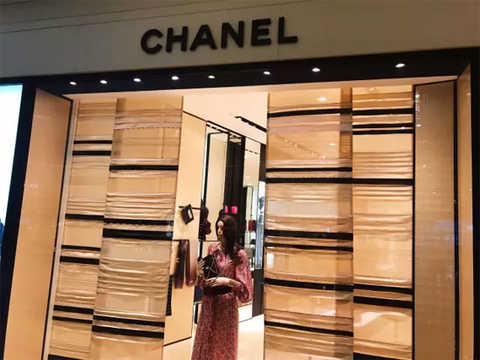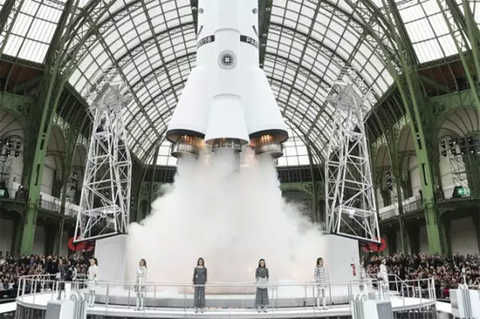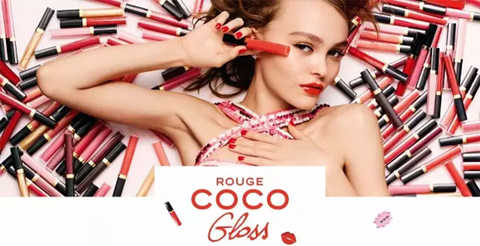It will fall behind without innovation. The performance of luxury brand Chanel continued its decline in 2016. Its sales revenue and profit recorded a sharp decline for two consecutive years. Compared with other luxury brands, it has been seriously lost. According to the latest news from French media LeMonde, Chanel has submitted the financial report for the whole year of last year to the industrial and commercial department of Amsterdam, the Netherlands. Data show that Chanel sales fell 9% to 5.67 billion US dollars in the previous fiscal year, operating profit fell 20% year-on-year to 1.28 billion US dollars, net profit fell 35% year-on-year to 874 million US dollars, profit margin is 15.4%, a sharp decline from 21.5% in 2015. For the decline in performance, Chanel explained in the report that it was mainly affected by the frequent terrorist attacks in Europe last year, especially in France, which led to the weak tourism industry and the depressed consumer desire for shopping. In addition, Chanel sold its British subsidiary Chanel Limited UK to another entity controlled by the Chanel Group last year, which also damaged the performance to some extent. Chanel Limited UK contributed about 11% of the total sales. Currently, the Chanel Group is mainly owned by Alain Wertheimer and Gerard Wertheimer and has not been listed yet. According to Bloomberg, the Wertheimer brothers’ dividends last year amounted to $3.4 billion, and their total wealth totaled about $22.4 billion. Since 2015, Chanel has faced performance challenges. During the fiscal year ended December 31, 2015, Chanel's operating profit fell 23% to $1.6 billion, and total sales fell 17% to $6.24 billion. The cosmetics and perfume business, which accounted for a large portion of Chanel's profits, had sales of US$2.91 billion in 2015, down 21% year-on-year. Security issues such as the 2015 European terrorist attacks have indeed eclipsed the European luxury goods industry. However, some analysts believe that compared with the performance of LVMH, Hermes, Kaiyun and other groups, the impact of this reason on Chanel's performance is likely to be overestimated, especially the group's "profit cow" cosmetics and perfume business began to fall in 2015, Enough to arouse the vigilance of the group. For the current Chanel, it is more important to look for reasons from within. Although Deloitte said in a financial report for Chanel, sales in 2016 were basically stable compared to 2015. However, compared with the soaring performance of the brand three years ago, Chanel is in a dilemma in performance in the past two years. Chanel's truly capable rocket launcher for the 2017 Fall Winter collection An earlier analysis article pointed out that Chanel's current strategic direction has already had problems. The first is to do the cost, the heavy money to do the show. After the last time in the show to build a simulation rocket, Chanel built a second Eiffel Tower in this year's Gaoding show. Commentator Ana Andjelic posted a criticism after the release of the 2017 Fall/Winter space series. Too much emphasis on the Chanel layout of the show is misleading the future direction of luxury brands, making fashion more and more superficial and unable to withstand scrutiny. What is even more alarming is that few people in the industry dare to criticize the luxury giant Chanel. Because Chanel spends a lot of money on advertising marketing, it is an important customer of many fashion media. Therefore, most of the media comments after each fashion show focus on the topical show installations, which is precisely because of the lack of change. There is not much room for discussion about the product. The biggest problem is still the product. Some industry believes that Chanel's ready-to-wear products have not been innovated for many years, almost every season is based on the classic tweed suits, and each season's deformation is almost "changing soup without dressing", lack of design Innovation. Chanel also seems to be concerned about social issues, such as the computer room of the Spring/Summer 2017 collection. But in addition to turning the show into a data center and fabricating the fiber into the tweed fabric, the show does not reflect the characteristics of the digital age. The theme of the series remains as usual in the “landscape†rather than the “contentâ€. In a huge computer room, the data floating in the invisible is still rendered by tangible color fiber, which is more or less disappointing. After the new product went on the market, some analysts thought that the new product in the window and the server together could not see what the brand wanted to express. On the surface, it embraces new technology, but in fact it still follows the old thinking. Some people think it is hypocritical futurism. Consumers are increasingly not buying such grand scenes and topic marketing. Although they have stimulated the topicality of social media, they have not brought more consumers into Chanel's stores. Young people want something more fresh. Sense of design. Of course, the garment business “not making money†is already the common sense of the luxury goods industry. In terms of accessories, the brand has also been seriously lacking in innovative labeling in recent years. In addition to the classic models such as Chanel 2.55, the handbags products have not highlighted the new style. This year, the new Gabrielle handbags will be vigorously promoted, and the sales status remains to be tested. In contrast, Vintage Chanel in the second-hand market is more popular. In terms of footwear, in addition to the more popular classic two-tone shoes, only straw sneakers have received good response, and the style has been launched for some time. As for core business cosmetics and perfumes, although the department's performance data has not been disclosed by the media, the 2015 results have already turned red. At the end of the year, Chanel and Coty Group reached an agreement to sell their popular make-up brand Bourjois to Coty Group in a non-cash form of about 15% of the Group A shares, which accounted for 4.2% of the group's shares, which affected the 2016 performance to some extent. . In addition, in order to boost the perfume business, Chanel launched the new version of No.5 L'eau perfume last year, and will continue to launch Gabrielle perfume this year. However, some analysts pointed out that Chanel will face more and more pressure in this field. Chanel's rival, Louis Vuitton of LVMH Group, also pushed the perfume business 70 years ago last year. It is also in July this year that the Louis Vuitton perfume series officially entered China in full, competing with Chanel's Gabrielle launched in July. Data Map: Now, Chanel has increased its marketing efforts in the name of “the year of Gabrielleâ€. Taking China as an example, in April of this year, Chanel opened the CocoCafé coffee shop in Shanghai, mainly to stimulate the sales of beauty products. In terms of digitization, Chanel's market situation is not easy. Some analysts believe that the brand is in a state of vacillation, especially on key strategic issues such as e-commerce and millennials. For example, Chanel and LVMH have very different attitudes toward e-commerce. Chanel Pavlovsky, president of Chanel's fashion department, said in an interview in May that he is still cautious about e-commerce. Contrary to other luxury brands slowing down or stopping adding physical stores, Chanel continues to expand its physical stores. It is reported that in 2018, Chanel will open a new 600-square-meter store on the outskirts of St. Honore, Paris. The store in New York's 57th block is also under renovation, and new stores will be opened in Seoul and Tokyo. In 2015, Chanel also announced that it has fully entered e-commerce. However, its attitude has been erratic. So far, Chanel has been promoting e-commerce to some e-commerce platforms for testing water jewelry, glasses and beauty products. Now, Chanel's attitude towards e-commerce is conservative. This means that in the short term, Chanel is unlikely to push the core business including ready-to-wear accessories to e-commerce channels. The strategy of entering e-commerce will be limited to beauty and other parts. business. Competitor LVMH has already taken the lead in e-commerce strategy, this year officially launched self-built e-commerce 24 Sèvres, and took the lead in the physical department store Le Bon Marché and online e-commerce, to become more and more become the industry consensus new Retail model. 24 Sèvres is undoubtedly a challenge that cannot be ignored for the luxury goods industry including Chanel and the entire e-commerce structure. In addition to Louis Vuitton, Chanel's second biggest rival, Dior, is also undergoing a comprehensive overhaul. Thanks to the rejuvenation of creative director Maria Grazia Chiuri, Dior's first quarter results boosted significantly, with sales up 18% year-on-year to 500 million euros in the three months ended March 31, retail channel sales. Calculated at the actual exchange rate, it was up 19% from the same period last year. It is worth noting that the biggest threat to Chanel is the success of Dior's new products. The products that Maria Grazia Chiuri brings to Dior are really loved by the future generations of the millennials, and the iconic star products are repeated, whether it is the feminist “We Should All Be Feminists†declaration T-shirt or the white ribbon J. 'ADIOR cats and shoes have become frequent in social media and street shooting in just six months, and have become a strong driving force for sales. With LVMH officially acquiring Dior's fashion division for 6.5 billion euros, Louis Vuitton and Dior, two of the LVMH Group's ace, will put more pressure on Chanel. Some analysts pointed out that the disconnection between product and brand image is the most serious problem of Chanel. The paved show is obviously out of Chanel’s misunderstanding of a new generation of consumers, and the future consumer’s expectation of luxury brands is no longer an unattainable setting, but a cultural and emotional interaction, not a luxury. A waste of comparison, but a contest of taste and personality. For Chanel, the flaws have been exposed very clearly. Blindly only missed the market opportunity in danger, as Maureen Chiquet, who left Chanel’s global CEO in January last year, pointed out that for Chanel, it’s not the first thing you want to do, but how to keep it unique. Obviously, this must rely on product innovation. Now, the European tourism factor that affects Chanel's 2016 performance is improving. Some analysts have pointed out that the Paris tourism revitalization plan has achieved initial results. According to the latest data released by the French city of Paris, the number of hotels in the Greater Paris area in the first quarter of 2017 was close to 5.2 million, an increase of 12.5% ​​year-on-year, a record high in 10 years. Among them, the number of French tourists increased by 9.9% year-on-year, and foreign tourists increased by 16%. The highest increase was for Japanese tourists, 62%, Russian tourists increased by 51% and Chinese tourists increased by 40%. With the recovery of European tourism, the luxury goods industry is also welcoming a new round of growth. In the first half of this year, LVMH Group's revenue and profit returned to double-digit growth, sales rose 14.6% year-on-year to 19.714 billion euros, and net profit rose 24% to 3.64 billion euros. The total sales of Kaiyun Group increased by 28.2% year-on-year to 7.296 billion euros, and its luxury goods revenue increased by 29.7% year-on-year to 5.031 billion euros. The sales of Gucci, the core growth engine of the division, rose 45.4% to 2.832 billion euros. Dior's fashion division sales rose 17.2% year-on-year to 1.047 billion euros, while net profit rose 58% to 117 million euros. Hermes Group's sales increased by 8.3% year-on-year to 1.36 billion euros, and sales in the first half increased by 9.7% year-on-year to 2.7 billion euros. Whether the improvement of the market environment can help Chanel's performance improve, or Chanel has begun to recognize its own problems, time will give an answer. Microfiber Glass Cleaning Cloths
microfiber
glass clean dishcloth mainly include microfiber warp knitting glass cloth,
superfine fiber scales grain cloth, microfiber plush mirror cloth, etc., is a
microfiber polyester silk woven composite yarn, with the characteristics of superfine
fiber, strong water absorption, easy to corrupt, easy to clean, and surface
roughness relative to other fabrics and exquisite, decontamination in evidence,
not suitable for smooth working table clean, Such as glass and glassware, porcelain, home appliances,
high-grade home and so on, clean as new after wiping, is a good helper for
household and car cleaning work. Products can be packaged separately and retailed,
just as he functional cloth combination packaging retail, we uphold the concept
of superior quality, service first, look forward to your
cooperation.
Microfiber Glass Cleaning Cloths,Glass Cleaning Cloth,Microfiber Rags,Microfibre Cleaning Cloth Suzhou fortunate Textile co., Ltd , https://www.fortunatetextile.com

